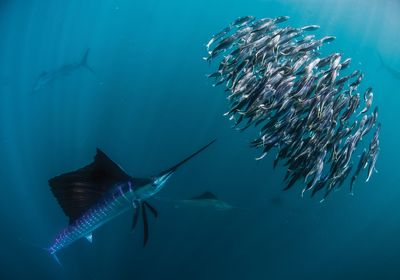ABOVE: The sailfish (Istiophorus spp.) chases a group of fish that have been lured by a bait trap. © istock.com, Luis Beristain
Every morning just before dawn, Eric Bricston launches his fleet from the shores of La Playita, a tiny beachside town on the Western coast of the Baja peninsula. After pushing their boats directly from the bone-white sandy shores, he and his fellow fishermen head toward Gordo Banks, a famous fishing spot known for its enormous pelagic fish such as wahoo tuna (Acanthocybium solandri), mahi-mahi (Coryphaena hippurus), blue marlin (Makaira nigricans), and other catches that weigh hundreds of pounds each.
Once a construction worker living in Utah, Bricston moved to Mexico in the 1980s. He established his fleet shortly after and now manages five dozen pangas—open-top, fiberglass fishing boats used throughout Mexico and Central and South America. Local people have been fishing in La Playita for generations. Now, it’s a popular tourist destination, especially for fishing—even as the number caught each year declines.
Throughout his time there, Bricston has been recording the catch his fleet brings back. In the beginning, he noted everything he fished each day, but that was a lot of effort, he said, so he switched to weekly fish reports. In 2010, he began publishing the data online.
Bricston intended his reports for fishermen to use so they could know which species were visiting the bay in a given week and what they might expect to catch. But in 2011, the logs caught the eye of William Gilly, a Stanford University marine biologist who studies the effects of climate change in the Gulf of California. Shortly after the 2009–2010 El Niño event, Gilly had begun a study on how and why Humboldt squid (Dosidicus gigas), normally abundant throughout the Pacific coast of Mexico and one of the main species caught commercially, had suddenly almost vanished from the region.1 While trying to hunt down information on the squid, Gilly came across Bricston’s logs online.
Curious about whether Bricston’s fleet had caught any squid in Gordo Banks, he got in touch, and the pair began emailing back and forth. They finally met in person at a taqueria in Cabo San Lucas in late December 2011 when Gilly was in the region. The conversation led to a collaboration that spanned the following decade, providing novel insights into ecosystem changes underway in the region.
“[Bricston] was super dedicated at keeping records,” said Gilly. And although he didn’t document the size of the squid he caught, something that Gilly’s team monitored separately through their own field experiments, Bricston provided Gilly with the numbers of fish and squid that his fleet had caught since the 1980s.
It was an ideal resource to complement Gilly’s investigation into the mystery of the disappearing squid. After the El Niño event, various data showed that the squid slowly returned to the region, but they were a smaller size than they had been previously. Gilly had an idea of why this might be.
Humboldt squid can have two phenotypes as adults, large and small, which depend on the water temperatures where they mature. “El Niño makes the water at depth unusually warm,” explained Gilly. Previous studies had revealed that during and following previous strong El Niño events such as one in 1996, average squid body size had dropped briefly—that is, there were more of the small phenotype—but returned back to normal after a few years.
After the 2010 event, however, the large phenotype failed to return at all. There was another El Niño warming event in 2015. “The squid just switched to this small phenotype. And they’ve been there ever since,” Gilly said.
In addition to direct effects on squid development of subsurface water temperatures, which increased year-on-year from 2010 to 2016, it’s possible that other factors contribute to the continued dominance of this small phenotype, such as a decrease in the abundance of sardines and other small pelagic fish that the squid prey on, Gilly and colleagues suggested in a recent paper describing their research.2 Sardines are sensitive to temperature, and their numbers also dropped dramatically in 2010.3 Since these two warming events, the squid fishing industry, which relies partly on large-size catch to remain commercially viable, has collapsed. Even though subsurface water temperatures have cooled slightly since 2016, large squid still haven’t returned to the region, perhaps reflecting an irreversible ecological shift in the region.
Gilly also started to piece together another story from Bricston’s data and from logs by another fisherman in the area, a former chemist and hobbyist named John Snow who looks for rare fish in the Los Cabos region. Snow has documented the fish he’s caught since the early 2000s, and also keeps daily personal logs, said Gilly, who first reached out to Snow in 2011. As panga fishermen often fishing in the same area, Bricston and Snow knew each other after meeting in 2003.
A couple of years ago, Gilly gathered all of the data Bricston and Snow had on the number of fish of each species they had caught between 2003 and 2020. From Bricston’s data on more than 250,000 fish, Gilly quickly gathered that for “all sport-harvested species, the numbers caught per trip had gone down consistently over the last 15 years.” Bricston has observed such trends, and there are some species that he doesn’t see at all anymore. Snow’s smaller but more diverse dataset corroborated the conclusion.
According to Gilly, the sport fishermen of Los Cabos blame the decrease on overfishing from commercial boats, which make up a billion-dollar industry in Mexico. But the true story is more complicated, he added. For one thing, migratory species typically aren’t as affected by overfishing as are local species, yet both sorts of fish are declining. What’s more, over the past 15 years, “the fishing pressure doesn’t seem to have gone up” based on commercial and sport fishing logs, Gilly said. Nevertheless, the cause of the decrease remains hard to untangle for pelagic fish. Multiple factors may be at play simultaneously, said Gilly, who included the fish data in his group’s 2022 squid paper. “It’s a huge mess.”
“I thought [the study] was great,” said Andrew Leising, a research oceanographer at the Southwest Fisheries Science Center, part of the National Oceanic and Atmospheric Administration, who was not involved in the work. “It shows something we’ve been thinking about for a long time, which is how the changes in the temperature of the deeper water is going to affect animals, particularly squid.” He added that the situation may be more complex for other marine species, noting that the effects of climate and other factors on many migratory fish are hard to tease out because these species experience so many different environments and fishing pressures as they travel.
What’s clear to Gilly and other scientists, though, is how much research like this benefits from data collected by citizen scientists. Phil Hastings, curator emeritus at the Scripps Institution of Oceanography, said that Snow has donated more than 100 specimens to the institution’s collection, some of which were previously unidentified. Snow also provides photographs and descriptions to Ross Robertson, a marine biologist at the Smithsonian Tropical Research Institute in Panama who runs and maintains multiple websites documenting the fish in the greater Caribbean and the Tropical Eastern Pacific. Such data provide “information on patterns of diversity,” Robertson said. “And that’s useful for conservation and management.”
Since the pandemic, Bricston has stopped keeping fishing logs since the process is time-consuming. He’s also close to retirement and is in the process of downsizing now that his sons have left home. Gilly said that there should likely be a permanent position counting and logging fish in Los Cabos, but that so far, there’s no such role. “It’s a really unique and valuable dataset,” Gilly said of Bricston’s fish reports, “It’s really worth doing because it’s a good independent source of what’s really going on.”
References
- Carlos J. Robinsonet al., Prolonged decline of jumbo squid (Dosidicus gigas) landings in the Gulf of California is associated with chronically low wind stress and decreased chlorophyll a after El Niño 2009–2010, Fisheries Research, 173(2), 2016, 128-138.
- William Gilly et al. Long-term hydrographic changes in the Gulf of California and ecological impacts: A crack in the World’s Aquarium?, Progress in Oceanography, 206, 2022, 102857.
- David Petatán-Ramírez et al. Potential changes in the distribution of suitable habitat for Pacific sardine (Sardinops sagax) under climate change scenarios, Deep Sea Research Part II: Topical Studies in Oceanography, 169–170, 2019, 104632.






